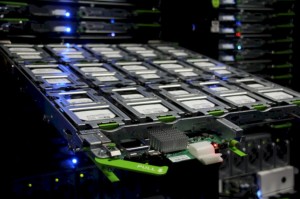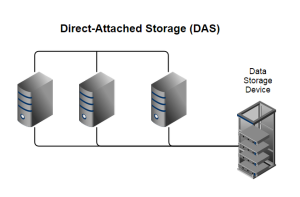Storage in a Data Center

Welcome everyone!
In today’s post we’re going to talk about the storage system in a Data Center. This is one of the most important aspects of these infrastructures, so it’s important to choose the best solution on each case depending on our needs.
But before analyzing the different options we have, it’s important to identify which are our main demands. IOPS (Input Output Per Second)? Capacity? Backup? Caché? Protocols? Price? …There are a lot of things to worry about, most of which are in this page.
So now, let’s take a look to the most important storage methods:
DAS (Direct Attached Storage) is the traditional method and the most simple. It consists in connecting the storage device directly to the workstation that uses it. The main protocols used in this type of system are SCSI, SAS or FiberChannel. The advantages of this system are a high bandwidth, fast access time, security and low cost, while the main disadvantage is the inability to share information with other servers.
NAS (Network Attached Storage) is a storage method that consists in sharing all the information from a server with all the other servers connected on the same network. Usually this devices use operating systems optimized to use protocols as CIFS, NFS, FTP or TFTP. The advantages of this method are the easy scalability, reutilization of the network infrastructure mounted, high availability and a simple management, while the main disadvantages are that sometimes it can cause bottleneck and a low performance and reliability due to the shared use if the communications.
SAN (Storage Area Network) is a network totally dedicated to the storage of data that is connected to the communication network of a company. All SAN devices must have an interface connection to the SAN network and an interface connection to the traditional LAN network. SAN networks can use fiber channels, so they can get speeds up to 100MB/s, a number that can be even higher if we connect more access connections to the SAN devices. A characteristic of a SAN network is that it allows to share data between devices without affecting the performance of user traffic, due to they go through different networks. The main advantages of this method are security, availability, virtualization capacity and resources consolidation, while the main disadvantage is a higher cost than the previous methods.
Another option to store data is the cloud storage, a way to have all the information we need virtualized. This is a method so used in some companies to save their backups copies. We can implement the cloud storage in our own company (with own equipment), or we can rent the service in a company that offers it (hiring the services that we need and without the need of buying all the equipment).
For the design of our particular case, the data center for a financial company, we will use equipment from IBM. We will implement a SAN solution, which is the best option to control the storage of the company and manage it as well as we can. Most probably we are going to use a system storage like IBM System Storage SAN768B-2 and SAN384B-2, which provides private and cloud storage. Maybe we will use the cloud storage for the backup, a solution that let recovers the information in case of total failure.
So that’s all for today. We hope you have learn something new about storage in Data Centers, and we expect you’re here on the next post. See you soon!





